warning light MAZDA MODEL MPV 2005 (in English) Owner's Guide
[x] Cancel search | Manufacturer: MAZDA, Model Year: 2005, Model line: MODEL MPV, Model: MAZDA MODEL MPV 2005Pages: 336, PDF Size: 5.31 MB
Page 126 of 336

Black plate (126,1)
Install the chains on the front tires.
Don't use chains on the rear tires.
Use only SAE Class“S”chains, and make
sure they fit.
Installing the chains
1. Remove the wheel covers, or the chain
bands will scratch them.
2. Secure the chains on the front tires as
tightly as possible. Always follow the
chain manufacturer's instructions.
3. Retighten the chains after driving 1/
2―1 km (1/4―1/2 mile).
Driving In Flooded Area
WARNING
Driving with Wet Brakes:
Driving with wet brakes is dangerous.
Increased stopping distance or the
vehicle pulling to one side when
braking could result in a serious
accident. Light braking will indicate
whether the brakes have been affected.
Dry the brakes by driving very slowly
and applying the brakes lightly until
brake performance returns to normal.
CAUTION
Make sure water does not enter the
vehicle interior or the engine area. The
vehicle interior could become wet or
the engine could be damaged.
4-10
Before Driving Your Mazda
Driving Tips
Mazda MPV_8T50-EA-04G_Edition1 Page126
Monday, June 28 2004 3:59 PM
Form No.8T50-EA-04G
Page 132 of 336
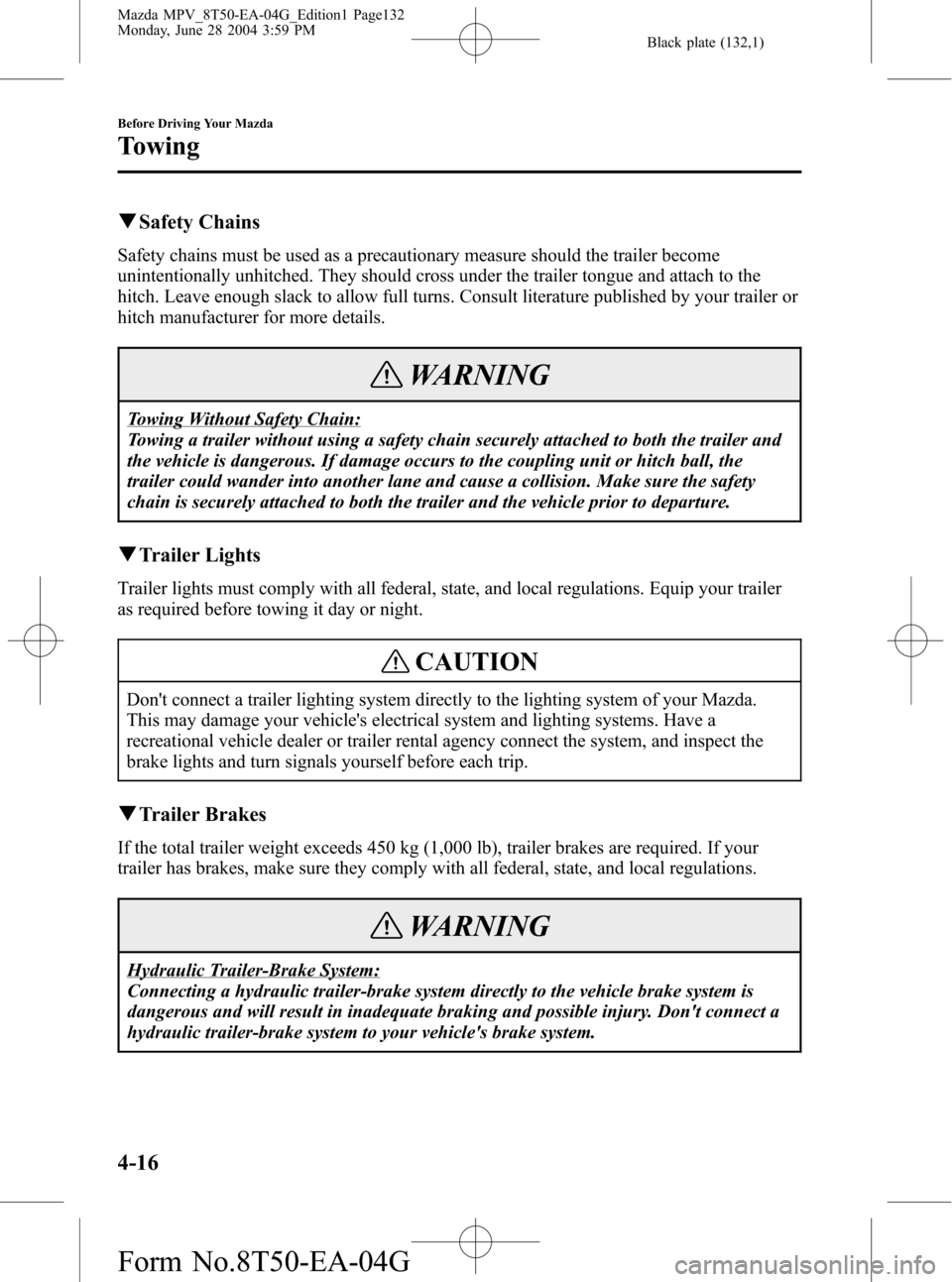
Black plate (132,1)
qSafety Chains
Safety chains must be used as a precautionary measure should the trailer become
unintentionally unhitched. They should cross under the trailer tongue and attach to the
hitch. Leave enough slack to allow full turns. Consult literature published by your trailer or
hitch manufacturer for more details.
WARNING
Towing Without Safety Chain:
Towing a trailer without using a safety chain securely attached to both the trailer and
the vehicle is dangerous. If damage occurs to the coupling unit or hitch ball, the
trailer could wander into another lane and cause a collision. Make sure the safety
chain is securely attached to both the trailer and the vehicle prior to departure.
qTrailer Lights
Trailer lights must comply with all federal, state, and local regulations. Equip your trailer
as required before towing it day or night.
CAUTION
Don't connect a trailer lighting system directly to the lighting system of your Mazda.
This may damage your vehicle's electrical system and lighting systems. Have a
recreational vehicle dealer or trailer rental agency connect the system, and inspect the
brake lights and turn signals yourself before each trip.
qTrailer Brakes
If the total trailer weight exceeds 450 kg (1,000 lb), trailer brakes are required. If your
trailer has brakes, make sure they comply with all federal, state, and local regulations.
WARNING
Hydraulic Trailer-Brake System:
Connecting a hydraulic trailer-brake system directly to the vehicle brake system is
dangerous and will result in inadequate braking and possible injury. Don't connect a
hydraulic trailer-brake system to your vehicle's brake system.
4-16
Before Driving Your Mazda
Towing
Mazda MPV_8T50-EA-04G_Edition1 Page132
Monday, June 28 2004 3:59 PM
Form No.8T50-EA-04G
Page 134 of 336
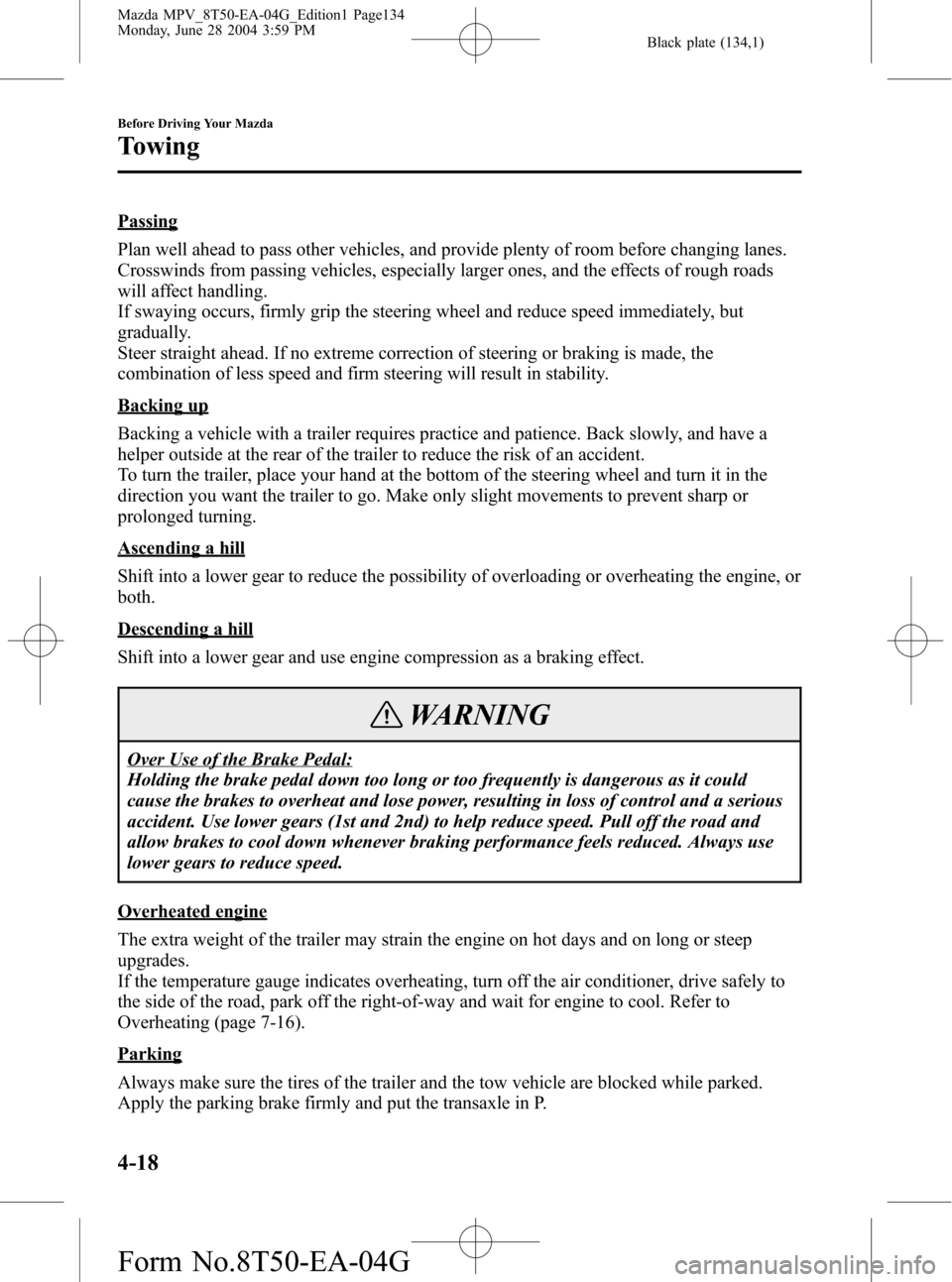
Black plate (134,1)
Passing
Plan well ahead to pass other vehicles, and provide plenty of room before changing lanes.
Crosswinds from passing vehicles, especially larger ones, and the effects of rough roads
will affect handling.
If swaying occurs, firmly grip the steering wheel and reduce speed immediately, but
gradually.
Steer straight ahead. If no extreme correction of steering or braking is made, the
combination of less speed and firm steering will result in stability.
Backing up
Backing a vehicle with a trailer requires practice and patience. Back slowly, and have a
helper outside at the rear of the trailer to reduce the risk of an accident.
To turn the trailer, place your hand at the bottom of the steering wheel and turn it in the
direction you want the trailer to go. Make only slight movements to prevent sharp or
prolonged turning.
Ascending a hill
Shift into a lower gear to reduce the possibility of overloading or overheating the engine, or
both.
Descending a hill
Shift into a lower gear and use engine compression as a braking effect.
WARNING
Over Use of the Brake Pedal:
Holding the brake pedal down too long or too frequently is dangerous as it could
cause the brakes to overheat and lose power, resulting in loss of control and a serious
accident. Use lower gears (1st and 2nd) to help reduce speed. Pull off the road and
allow brakes to cool down whenever braking performance feels reduced. Always use
lower gears to reduce speed.
Overheated engine
The extra weight of the trailer may strain the engine on hot days and on long or steep
upgrades.
If the temperature gauge indicates overheating, turn off the air conditioner, drive safely to
the side of the road, park off the right-of-way and wait for engine to cool. Refer to
Overheating (page 7-16).
Parking
Always make sure the tires of the trailer and the tow vehicle are blocked while parked.
Apply the parking brake firmly and put the transaxle in P.
4-18
Before Driving Your Mazda
Towing
Mazda MPV_8T50-EA-04G_Edition1 Page134
Monday, June 28 2004 3:59 PM
Form No.8T50-EA-04G
Page 137 of 336
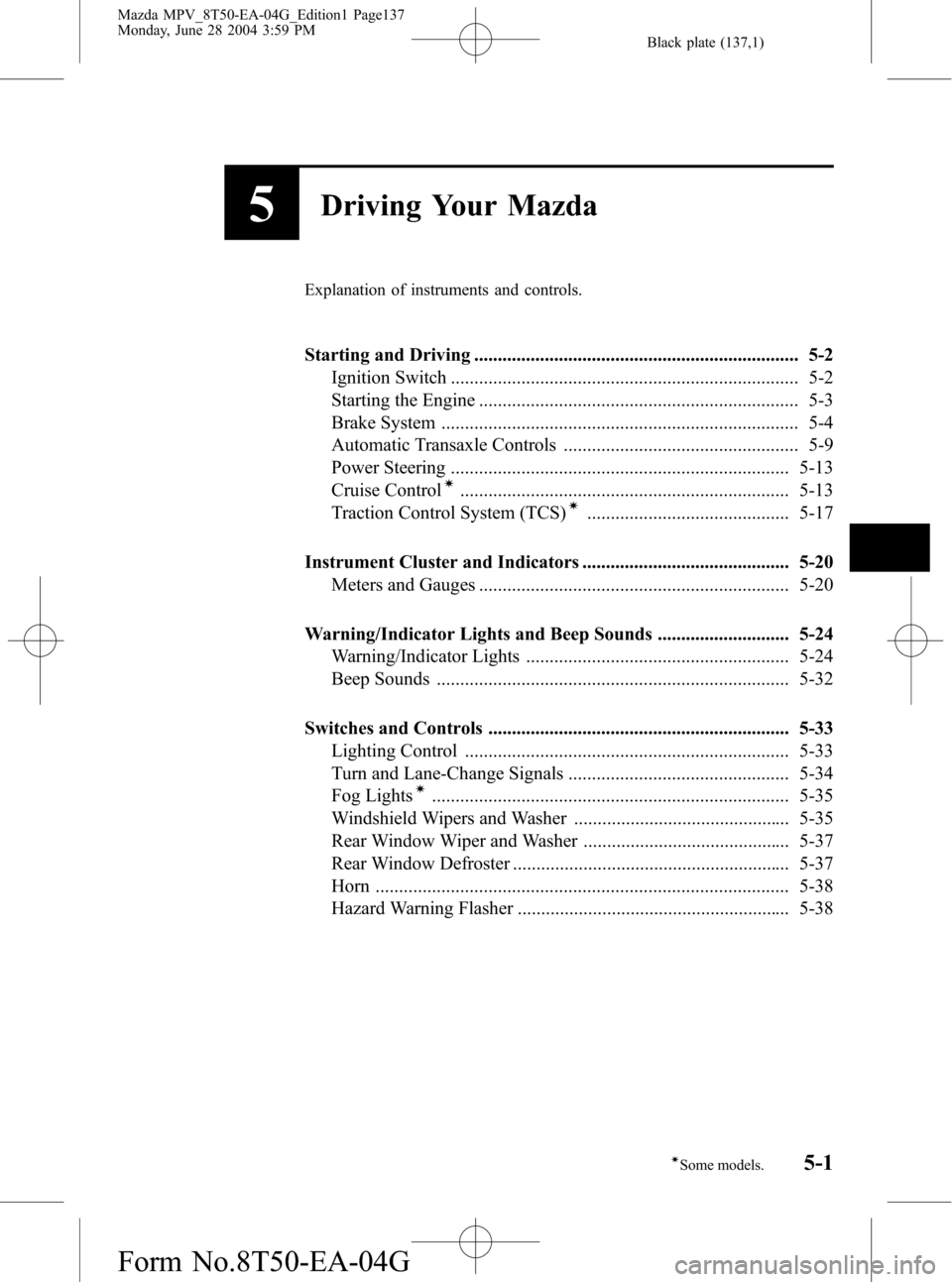
Black plate (137,1)
5Driving Your Mazda
Explanation of instruments and controls.
Starting and Driving ..................................................................... 5-2
Ignition Switch .......................................................................... 5-2
Starting the Engine .................................................................... 5-3
Brake System ............................................................................ 5-4
Automatic Transaxle Controls .................................................. 5-9
Power Steering ........................................................................ 5-13
Cruise Control
í...................................................................... 5-13
Traction Control System (TCS)í........................................... 5-17
Instrument Cluster and Indicators ............................................ 5-20
Meters and Gauges .................................................................. 5-20
Warning/Indicator Lights and Beep Sounds ............................ 5-24
Warning/Indicator Lights ........................................................ 5-24
Beep Sounds ........................................................................... 5-32
Switches and Controls ................................................................ 5-33
Lighting Control ..................................................................... 5-33
Turn and Lane-Change Signals ............................................... 5-34
Fog Lights
í............................................................................ 5-35
Windshield Wipers and Washer .............................................. 5-35
Rear Window Wiper and Washer ............................................ 5-37
Rear Window Defroster ........................................................... 5-37
Horn ........................................................................................ 5-38
Hazard Warning Flasher .......................................................... 5-38
5-1íSome models.
Mazda MPV_8T50-EA-04G_Edition1 Page137
Monday, June 28 2004 3:59 PM
Form No.8T50-EA-04G
Page 138 of 336
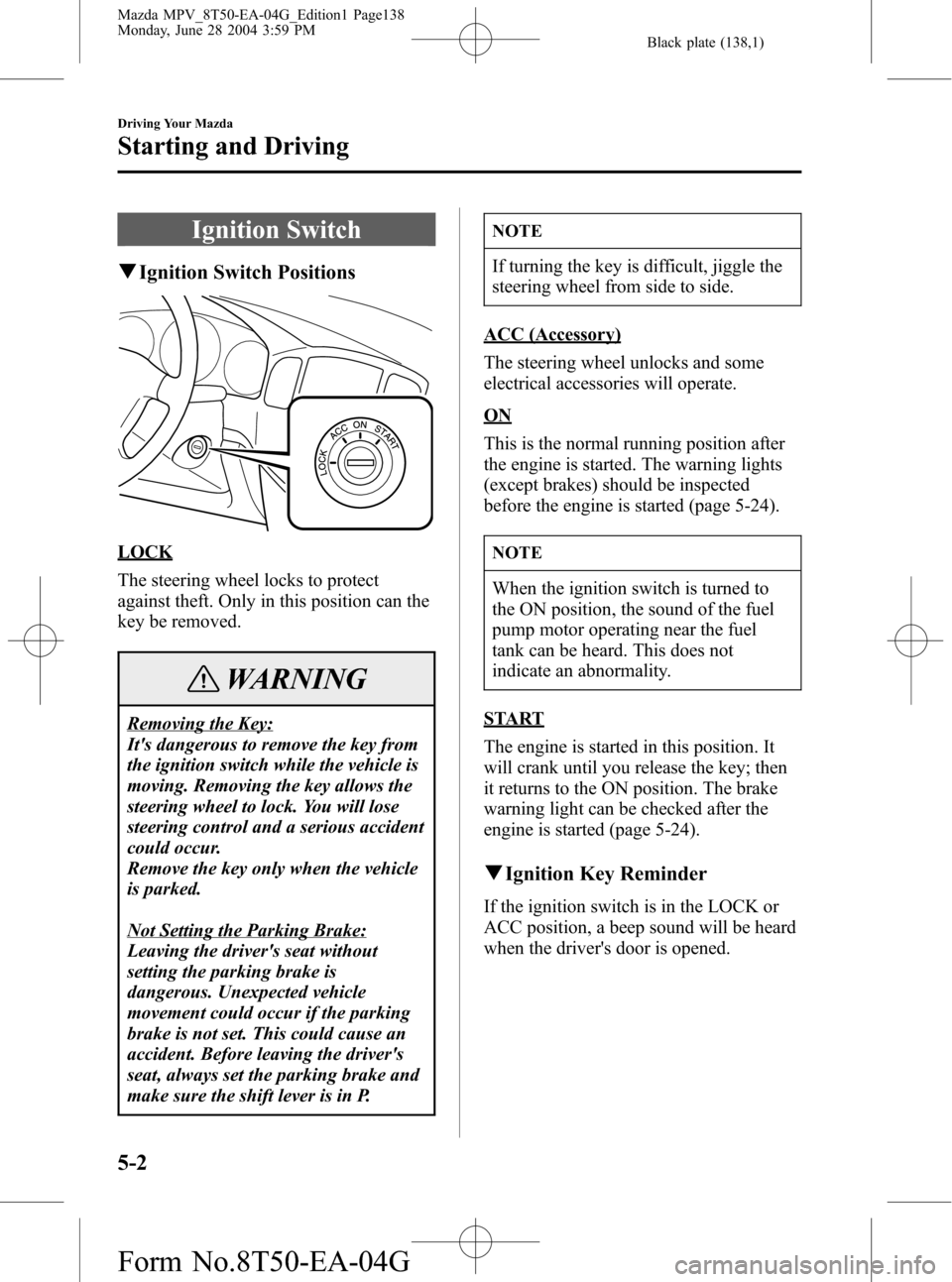
Black plate (138,1)
Ignition Switch
qIgnition Switch Positions
LOCK
The steering wheel locks to protect
against theft. Only in this position can the
key be removed.
WARNING
Removing the Key:
It's dangerous to remove the key from
the ignition switch while the vehicle is
moving. Removing the key allows the
steering wheel to lock. You will lose
steering control and a serious accident
could occur.
Remove the key only when the vehicle
is parked.
Not Setting the Parking Brake:
Leaving the driver's seat without
setting the parking brake is
dangerous. Unexpected vehicle
movement could occur if the parking
brake is not set. This could cause an
accident. Before leaving the driver's
seat, always set the parking brake and
make sure the shift lever is in P.
NOTE
If turning the key is difficult, jiggle the
steering wheel from side to side.
ACC (Accessory)
The steering wheel unlocks and some
electrical accessories will operate.
ON
This is the normal running position after
the engine is started. The warning lights
(except brakes) should be inspected
before the engine is started (page 5-24).
NOTE
When the ignition switch is turned to
the ON position, the sound of the fuel
pump motor operating near the fuel
tank can be heard. This does not
indicate an abnormality.
START
The engine is started in this position. It
will crank until you release the key; then
it returns to the ON position. The brake
warning light can be checked after the
engine is started (page 5-24).
qIgnition Key Reminder
If the ignition switch is in the LOCK or
ACC position, a beep sound will be heard
when the driver's door is opened.
5-2
Driving Your Mazda
Starting and Driving
Mazda MPV_8T50-EA-04G_Edition1 Page138
Monday, June 28 2004 3:59 PM
Form No.8T50-EA-04G
Page 140 of 336

Black plate (140,1)
Brake System
qFoot Brake
Your Mazda has power-assisted brakes
that adjust automatically through normal
use.
Should power-assist fail, you can stop by
applying greater force than normal to the
brake pedal. But the distance required to
stop will be greater than usual.
WARNING
Coasting with the Engine Off:
Continuing to coast when the engine
is stalled or turned off is dangerous.
Braking will require more effort, and
the brake's power-assist could be
depleted if you pump the brake. This
will cause longer stopping distances or
even an accident. Don't continue
coasting when the engine is stalled or
turned off, find a safe place to stop.
Riding the Brakes:
Driving with your foot continuously
on the brake pedal or steadily applying
the brakes for long distances is
dangerous. This causes overheated
brakes, resulting in longer stopping
distances or even total brake failure.
This could cause loss of vehicle
control and a serious accident. Avoid
continuous application of the brakes.
Shift to a lower gear when going down
steep hills.
WARNING
Driving with Wet Brakes:
Driving with wet brakes is dangerous.
Increased stopping distance or the
vehicle pulling to one side when
braking could result in a serious
accident. Light braking will indicate
whether the brakes have been affected.
Dry the brakes by driving very slowly
and applying the brakes lightly until
brake performance is normal.
qParking Brake
CAUTION
Driving with the parking brake on will
cause excessive wear of the brake
linings or pads.
NOTE
For parking in snow, refer to Winter
Driving (page 4-9) regarding parking
brake use.
5-4
Driving Your Mazda
Starting and Driving
Mazda MPV_8T50-EA-04G_Edition1 Page140
Monday, June 28 2004 3:59 PM
Form No.8T50-EA-04G
Page 141 of 336

Black plate (141,1)
Setting the parking brake
Depress the brake pedal, then pull the
brake handle fully upward.
Releasing the parking brake
Depress the brake pedal, then pull the
handle up and press the button. Lower the
handle all the way down while holding in
the button.
qBrake System Warning Light
This warning has the following functions:
Parking brake warning
The light comes on when the parking
brake is applied with the ignition switch
in the START or ON position. It goes off
when the parking brake is fully released.
Low brake fluid level warning/
Electronic brake force distribution
system warning
If the light stays on after the parking brake
is fully released, you may have a brake
problem.
Drive to the side of the road and park off
the right-of-way.
Low brake fluid level warning
You may notice that the pedal is harder to
push or that it may go closer to the floor.
In either case, it will take longer to stop
the vehicle.
1. With the engine stopped, check the
brake fluid level immediately and add
fluid as required (page 8-15).
2. After adding fluid, check the light
again.
If the warning light remains on, or if the
brakes do not operate properly, do not
drive the vehicle. Have it towed to an
Authorized Mazda Dealer.
Driving Your Mazda
Starting and Driving
5-5
Mazda MPV_8T50-EA-04G_Edition1 Page141
Monday, June 28 2004 3:59 PM
Form No.8T50-EA-04G
Page 142 of 336

Black plate (142,1)
Even if the light goes off, have your brake
system inspected as soon as possible.
Electronic brake force distribution
system warning
If the electronic brake force distribution
control unit determines that some
components are operating incorrectly, the
control unit may turn the brake system
warning light on.
In this case, the ABS warning light comes
on at the same time (page 5-28).
WARNING
Brake Warning Light:
Driving with the brake system warning
light on is dangerous. It indicates that
your brakes may not work at all or
that they could completely fail at any
time. If this light remains on, after
checking that the parking brake is
fully released, have the brakes
inspected immediately. Don't drive
with this light on, and contact an
Authorized Mazda Dealer to have the
brakes inspected as soon as possible.
ABS Warning Light and Brake
Warning Light on at the Same Time:
Driving when the brake system
warning light and ABS warning light
are on at the same time is dangerous.
When both lights are on, the rear
wheels could lock more quickly in an
emergency stop than under normal
circumstances.
Don't drive with both lights on, and
contact an Authorized Mazda Dealer
to have the brakes inspected as soon
as possible.
qAnti-Lock Brake System (ABS)í
The ABS control unit continuously
monitors the speed of each wheel. If one
is about to lock up, the ABS responds by
automatically releasing and reapplying
that wheel's brake.
The driver will feel a slight vibration in
the brake pedal and may hear a chattering
noise from the brake system. This is
normal when the ABS operates. Don't
pump the brakes, continue to press down
on the brake pedal.
WARNING
ABS:
The ABS cannot compensate for
unsafe and reckless driving, excessive
speed, tailgating (following another
vehicle too closely), and hydroplaning
(reduced tire friction and road contact
because of water on the road surface).
You can still have an accident. So
don't rely on ABS as a substitute for
safe driving.
NOTE
Braking distances may be longer on
loose surfaces (snow or gravel, for
example) which usually have a hard
foundation. A vehicle with a normal
braking system may require less
distance to stop under these conditions
because the tires will build up a wedge
of surface layer when the wheels skid.
5-6
Driving Your Mazda
íSome models.
Starting and Driving
Mazda MPV_8T50-EA-04G_Edition1 Page142
Monday, June 28 2004 3:59 PM
Form No.8T50-EA-04G
Page 143 of 336
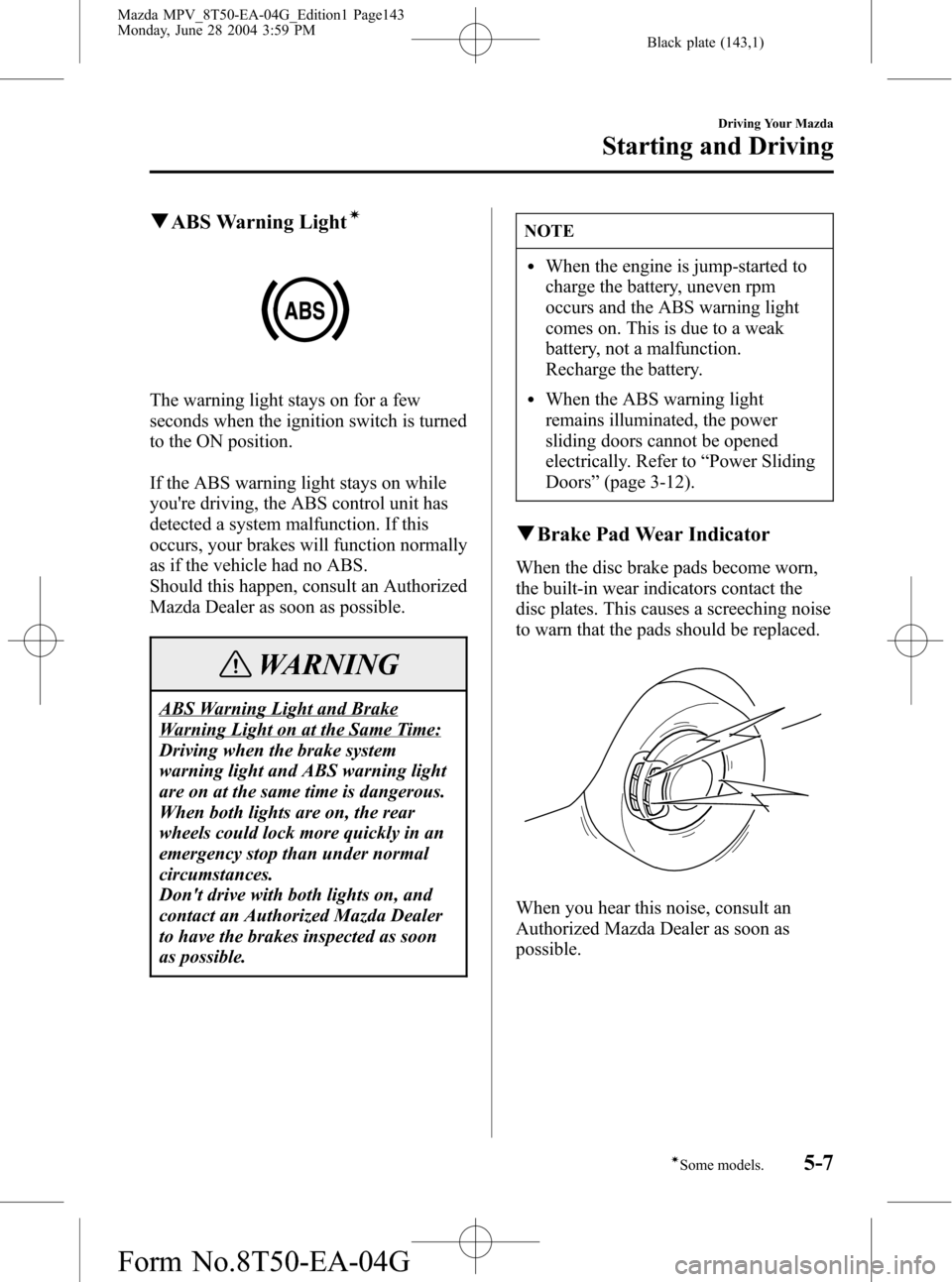
Black plate (143,1)
qABS Warning Lightí
The warning light stays on for a few
seconds when the ignition switch is turned
to the ON position.
If the ABS warning light stays on while
you're driving, the ABS control unit has
detected a system malfunction. If this
occurs, your brakes will function normally
as if the vehicle had no ABS.
Should this happen, consult an Authorized
Mazda Dealer as soon as possible.
WARNING
ABS Warning Light and Brake
Warning Light on at the Same Time:
Driving when the brake system
warning light and ABS warning light
are on at the same time is dangerous.
When both lights are on, the rear
wheels could lock more quickly in an
emergency stop than under normal
circumstances.
Don't drive with both lights on, and
contact an Authorized Mazda Dealer
to have the brakes inspected as soon
as possible.
NOTE
lWhen the engine is jump-started to
charge the battery, uneven rpm
occurs and the ABS warning light
comes on. This is due to a weak
battery, not a malfunction.
Recharge the battery.
lWhen the ABS warning light
remains illuminated, the power
sliding doors cannot be opened
electrically. Refer to“Power Sliding
Doors”(page 3-12).
qBrake Pad Wear Indicator
When the disc brake pads become worn,
the built-in wear indicators contact the
disc plates. This causes a screeching noise
to warn that the pads should be replaced.
When you hear this noise, consult an
Authorized Mazda Dealer as soon as
possible.
Driving Your Mazda
Starting and Driving
5-7íSome models. Mazda MPV_8T50-EA-04G_Edition1 Page143
Monday, June 28 2004 3:59 PM
Form No.8T50-EA-04G
Page 146 of 336

Black plate (146,1)
CAUTION
lShifting into P, N or R while the
vehicle is moving can damage your
transaxle.
lShifting into a driving gear or
reverse when the engine is running
faster than idle can damage the
transaxle.
R (Reverse)
In position R, the vehicle moves only
backward. You must be at a complete stop
before shifting to or from R, except under
rare circumstances as explained in
Rocking the Vehicle (page 4-8).
N (Neutral)
In N, the wheels and transaxle are not
locked. The vehicle will roll freely even
on the slightest incline unless the parking
brake or brakes are on.
WARNING
Shifting from N or P:
It's dangerous to shift from N or P
into a driving gear when the engine is
running faster than idle. If this is
done, the vehicle could move suddenly,
causing an accident or serious injury.
If the engine is running faster than
idle, don't shift from N or P into a
driving gear.
Shifting into N while Driving:
Shifting into N while driving is
dangerous. Engine braking cannot be
applied when decelerating which
could lead to an accident or serious
injury. Do not shift into N when
driving the vehicle.
CAUTION
Do not shift into N when driving the
vehicle. Doing so can cause transaxle
damage.
D (Drive)
D is the normal driving position. From a
stop, the transaxle will automatically shift
through a 5-gear sequence.
3 (Third)
The 3 position is helpful when driving in
heavy, slow-moving traffic and climbing
hills, for engine braking assist when going
down hills, or for starting on slick
surfaces and other situations where gentle
acceleration may be necessary.
Do not exceed 141 km/h (87 mph) in the
3 position.
2 (Second)
Use the 2 position for maximum power in
hard-pulling situations, or for climbing
and descending very steep grades.
Do not exceed 93 km/h (57 mph) in the 2
position.
WARNING
Sudden Engine-Braking:
Shifting down while driving on wet,
snowy, or frozen roads, or while
driving at high speeds causes sudden
engine braking, which is dangerous.
The sudden change in tire speed could
cause the tires to skid. This could lead
to loss of vehicle control and an
accident. Do not use sudden engine
braking on slippery road surfaces or at
high speeds.
5-10
Driving Your Mazda
Starting and Driving
Mazda MPV_8T50-EA-04G_Edition1 Page146
Monday, June 28 2004 3:59 PM
Form No.8T50-EA-04G